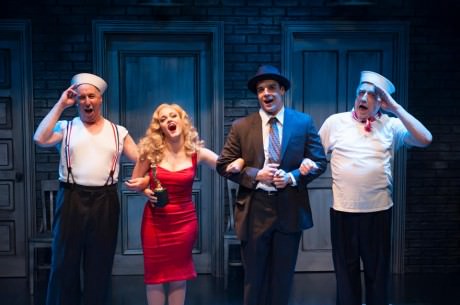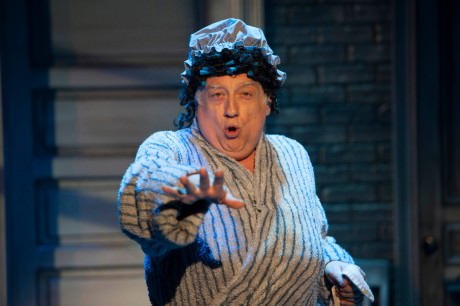You know you’re in the presence of a legend when the material doesn’t matter as much as the immaterial.
With the world premiere of Cloak and Dagger: Or the Case of the Golden Venus — Ed Dixon’s outrageous trunk show — Signature Theatre once again is killin’ it. Artistic Director Eric Schaeffer has justifiably earned his reputation of always thinking outside the black box — the man with the Midas touch. Even when his touch seems deceptively light-handed, Schaeffer remains master of this house. Still, Dixon’s presence permeates the place.
Billed as a send-up to film noir, in which a jaded, drunk-on-metaphors private eye gets reeled into a web of intrigue, it’s instantly clear that the omniscient force is not our clueless clue-sniffer and blonde-hound narrator Nick Cutter but the musical’s creator, composer and co-star Dixon, who dominates the stage even in his briefest transmorgrifying crossings as Character Man One.

A prolific playwright and four-decade Broadway veteran, Dixon, 65, has said he started writing Cloak and Dagger during his run with Mary Poppins at the New Amsterdam Theatre in summer 2011. He was inspired by Alfred Hitchcock’s The 39 Steps, a manic melodrama spinning through Hitch’s filmography using just four actors — a bloke playing opposite a multitasking broad and two “clowns” who change costumes at lightning speed to flesh out the ensemble.
In his YouTube-preserved 13-part cabaret based on his 2012 memoir Secrets of a Life on Stage … and Off, Dixon admits that anything he writes contains notes of autobiography. That must explain why Cloak and Dagger feels less like a whodunit than an extended “Who’s on First?” sketch. He’s a natural ham for which there’s apparently no cure. Vaudevillian one-liners pepper the dialogue like gunfire, and he inhabits everything from a randy Irish landlady’s bathrobe to a geezer nun’s habit.
He also morphs through multiple roles in his next project, a one-man show to be produced off-Broadway next year. Georgie: The Life and Death of George Rose chronicles a grimmer slice of his life: the shocking disclosure and need for closure over the 1988 murder of his friend and mentor in the Dominican Republic.
Comparatively light fare, Cloak and Dagger is a stew of film noir, burlesque, operetta, Looney Tunes, with winking nods to musicals from Jerry Herman’s Mame and La Cage aux Folles to backstage hits like Curtains; Kiss Me, Kate; 42nd Street; and a thinly veiled Titanic parody. Whew! (In a musical punch line, the opening strains of the first number, The Worst of Times, borrow from The Best of Times, Herman’s La Cage anthem, while the secondsong transforms Dickensian-like — or is that Dixonian-like? — into a titular echo.) About those orchestrations, created by 20-something Jordon Ross Weinhold on his Apple computer using Dixon’s handwritten scrawlings: pretty peppy! But Musical Director Jenny Cartney and her pit crew keep up with rollicking grace.
To paraphrase Humphrey Bogart’s Sam Spade in The Maltese Falcon: This is the stuff that (Broadway) dreams are made of.
As in that film noir classic, Cloak and Dagger has your private dick and your femme fatale (the lobby shop sells both T-shirts) plus yer mobsters, sailors, exotic dancers … only they resemble Benny Hill and Dame Edna. Also like Falcon, a coveted statue is at the core of Cloak and Dagger’s plot — for fun, let’s call it a Tony statuette. If not so illustrious, Dixon’s career might be cruelly subtitled the Case of the Missing Tony. Such is the lot of many an accomplished character actor.
Dixon’s three-octave range — he seemingly can sound two notes at once — is matched only by his thespian tool set. From dandy to dotty, tears-of-a-clown Rigoletto to regal Englishman, mysterious Max in Sunset Boulevard to rascally Old Max in How the Grinch Stole Christmas, you can’t teach this old dog new tricks as he has mastered them all. Though he performs with humble precision, his swagger cannot be snuffed. He’s the sun whom others merely orbit.
Romantic leads Doug Carpenter and Erin Driscoll bring dignified couth to Cloak’s kooky book and milked stereotypes. More than your average Joe Friday, Carpenter’s Cutter is 100% choice-cut beef. His resonant, robust bari-tones are radio-ready, though Sound Designer Lane Elms likely deserves some of the credit. The sound work is slick.
High-tailing across 1950s Manhattan, Carpenter shines in “Subway Song,” which Schaeffer cunningly choreographed as a thrill ride through a crowded urban milieu using but three nimble bodies. Some melodies are forgettable, but Carpenter’s luscious last note of “Love Is” might reverberate ’til next season. He blends self-effacing charm and gusto when his Big Day Out lands him on stage at a seedy dive to dance with bawdy Things One and Two in the giddy “Shake Your Maracas.”
As his siren-red moving target, Driscoll is va-va-va-VOOM. The two-time Helen Hayes Award recipient curvaceously swings from villainous to vivacious on a dime. Her “Doors Close” ballad is jaw-droppingly smoky. She’s vocally powerful and fisticuffs-fierce but achieves sparkling irony with such lines as “Thanks for being such a terrific audience,” addressing drifter Character Man Two (Christopher Bloch) wearing his flasher coat and foggy look. Bloch, too, transfigures in monumental ways, matching Dixon tit for twat. Twin towering talents from different fathers?
Colin K. Bills’ lighting design somehow engages the aural senses, sizzling and humming like an interrogation bulb, tilting from the dank interior of a PI’s blinds-drawn office to a dangerous dockside warehouse … from the top of the Empire State Building to the middle of the deep blue sea. Bills’ beams function as a teleportation machine, as do Kathleen Geldard’s snappy costume designs. Get-ups for Characters Man One and Two get only slightly askew as they giddy-up through their changes.

The minimalist set, made more minimalist three minutes in (no spoilers), showcases Daniel Conway’s peerless creativity via a steel rod and phallic — OK, gun-shaped — signage. Three doors punctuate a brick wall upstage to facilitate cues and enhance suspense. Conway avoids the obligatory phone booth, but above the retro checkerboard floor suspends four-sided transom stained with vintage New York cityscapes pinched at the corners with lamppost-like finials. On my side, I spied the defunct Capitol Theatre, an MGM icon north of Times Square famous for showcasing The Wizard of Oz during its original 1939 run.
Cloak and Dagger is unflinchingly derivative. But if you keep up with it, this razor-sharp farce offers clues into Dixon’s whirlwind of a imagination — proof positive that he may be among theater’s last true troubadours.
Running Time: 90 minutes, with no intermission.
Cloak and Dagger: Or the Case of the Golden Venus plays through July 6, 2014 in The Max at Signature Theatre – 4200 Campbell Avenue, in Arlington, VA. For tickets, call (703) 820-9771, or order them online.
LINK
Ed Dixon on Writing and Appearing in ‘Cloak and Dagger’ at Signature Theatre.




